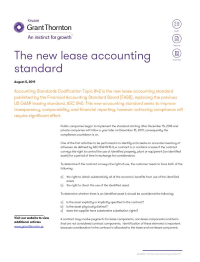-
Financial statements audits
Financial statement audits
-
Compliance audits
Compliance audits
-
Compilations and reviews
Compilations and audit
-
Agreed-upon procedures
Agreed-upon procedures
-
Corporate and business tax
Our trusted teams can prepare corporate tax files and ruling requests, support you with deferrals, accounting procedures and legitimate tax benefits.
-
International tax
Our teams have in-depth knowledge of the relationship between domestic and international tax laws.
-
Tax compliance
Business Tax
-
Individual taxes
Individual taxes
-
Estate and succession planning
Estate and succession planning
-
Global mobility services
Through our global organisation of member firms, we support both companies and individuals, providing insightful solutions to minimise the tax burden for both parties.
-
Sales and use tax and indirect taxes
SUT/ VAT & indirect taxes
-
Tax incentives program
Tax incentives program
-
Transfer Pricing Study
The laws surrounding transfer pricing are becoming ever more complex, as tax affairs of multinational companies are facing scrutiny from media, regulators and the public
-
Business consulting
Our business consulting services can help you improve your operational performance and productivity, adding value throughout your growth life cycle.
-
Forensic and investigative services
At Grant Thornton, we have a wealth of knowledge in forensic services and can support you with issues such as dispute resolution, fraud and insurance claims.
-
Fraud and investigations
The commercial landscape is changing fast. An ever more regulated environment means organizations today must adopt stringent governance and compliance processes. As business has become global, organizations need to adapt to deal with multi-jurisdictional investigations, litigation, and dispute resolution, address the threat of cyber-attack and at the same time protect the organization’s value.
-
Dispute resolutions
Our independent experts are experienced in advising on civil and criminal matters involving contract breaches, partnership disputes, auditor negligence, shareholder disputes and company valuations, disputes for corporates, the public sector and individuals. We act in all forms of dispute resolution, including litigation, arbitration, and mediation.
-
Business risk services
We can help you identify, understand and manage potential risks to safeguard your business and comply with regulatory requirements.
-
Internal audit
We work with our clients to assess their corporate level risk, identify areas of greatest risk and develop appropriate work plans and audit programs to mitigate these risks.
-
Service organization reports
As a service organization, you know how important it is to produce a report for your customers and their auditors that instills confidence and enhances their trust in your services. Grant Thornton Advisory professionals can help you determine which report(s) will satisfy your customers’ needs and provide relevant information to your customers and customers’ auditors that will be a business benefit to you.
-
Transaction advisory services
Transactions are significant events in the life of a business – a successful deal that can have a lasting impact on the future shape of the organizations involved. Because the stakes are high for both buyers and sellers, experience, determination and pragmatism are required to bring deals safely through to conclusion.
-
Mergers and acquisitions
Globalization and company growth ambitions are driving an increase in M&A activity worldwide as businesses look to establish a footprint in countries beyond their own. Even within their own regions, many businesses feel the pressure to acquire in order to establish a strategic presence in new markets, such as those being created by rapid technological innovation.
-
Valuations
We can support you throughout the transaction process – helping achieve the best possible outcome at the point of the transaction and in the longer term.
-
Recovery and reorganization
We provide a wide range of services to recovery and reorganisation professionals, companies and their stakeholders.
Accounting Standards Codification Topic 842 is the new lease accounting standard published by the Financial Accounting Standard Board (FASB), replacing the previous US GAAP leasing standard, ASC 840. This new accounting standard seeks to improve transparency, comparability, and financial reporting, however achieving compliance will require significant effort.
Public companies began to implement the standard starting after December 15, 2018 and private companies will follow a year later on December 15, 2019, consequently the compliance countdown is on.
One of the first activities to be performed is to identify and create an accurate inventory of all leases. As defined by ASC 842-10-15-3, a contract is or contains a lease if the contract conveys the right to control the use of identified property, plant or equipment (an identified asset) for a period of time in exchange for consideration.
To determine if the contract conveys the right of use, the customer needs to have both of the following:
- the right to obtain substantially all of the economic benefits from use of the identified asset.
- the right to direct the use of the identified asset.
To determine whether there is an identified asset it should be considered the following:
- is the asset explicitly or implicitly specified in the contract?
- is the asset physically distinct?
- does the supplier have substantive substitution rights?
A contract may involve payments for lease components, non-lease components and items that are not considered contract components. Identification of these elements is important because consideration in the contract is allocated to the lease and non-lease component.
As an accounting policy, the lessees may opt to not separate lease and non-lease components for a specific class of underlying asset and may account for both as a single component. Lessors have a similar option, but it is limited to circumstances where the non-lease component(s) would be accounted for under the revenue recognition guidance (ASC 606) and both (1) the timing and pattern of transfer are the same for the non-lease component(s) and associated lease component and (2) the lease component, if accounted for separately, would be classified as an operating lease.
Lessees are the most significantly affected by the new leasing standard. ASC 842 retains the two-model approach of classifying leases as operating or finance, however most leases will now be recorded on the balance sheet. When a lease is recorded, a liability must be recognized based on the present value of future lease payments, with an offsetting entry to recognize a right-of-use payment. While both operating and finance leases will be recorded on the balance sheet, the expense recognition pattern differs. Operating leases require lease expense to be recognized on a straight-line basis over the lease term, while finance leases require the lessee to recognize interest expense and amortization expense.
Lessors will also see an effect on their financial statements and disclosures. The profit recognition requirements under lessor model match those under the new revenue recognition requirements, issued by the FASB. The lessor is required to classify a lease as a sales-type lease, direct financing lease, or operating lease based on ASC 842 new classification criteria.
Upon adoption of the lease standard it is required to apply a modified retrospective transition approach. The lessors and lessees can choose to:
- adjust comparative periods, which requires to apply the lease standard to each lease that existed at the beginning of the earliest comparative period presented in the financial statements, as well as leases entered into after that date or
- do not adjust comparative periods, which requires to apply the lease standard to each lease that had commenced as of the beginning of the reporting period in which the entity first applies the lease standard with a cumulative effect adjustment as of that date (prior comparative periods would not be adjusted under this method).
ASC 842 provides various optional transition practical expedients that must be elected as a package and applied consistently by an entity to all its leases that commenced before the effective date. An entity need not reassess:
- whether any expired or existing contracts are or contain leases.
- the lease classification for any expired or existing leases.
- initial direct costs for any existing leases.
Another practical expedient consists in the election to use hindsight during the transition period. This election allows an entity to use its current knowledge or current expectations as of the effective date, instead of its knowledge and expectations as of the latest assessment date under legacy GAAP, when determining the lease term and assessing whether impairment of the right-of-use asset exists during the transition period.
The Board issued an update to ASC 842 whereby there is an optional transition practical expedient to not evaluate under ASC 842 existing or expired land easements that were not previously accounted for as leases under ASC 840.
Implementing the new lease standard will require a new perspective on Company’s current accounting lease contracts and processes. A seamless transition and implementation of the ASC 842 accounting guidance will require deep technical accounting skills, the use of updated technology and a comprehensive understanding of the potential impacts to the financial statements.


